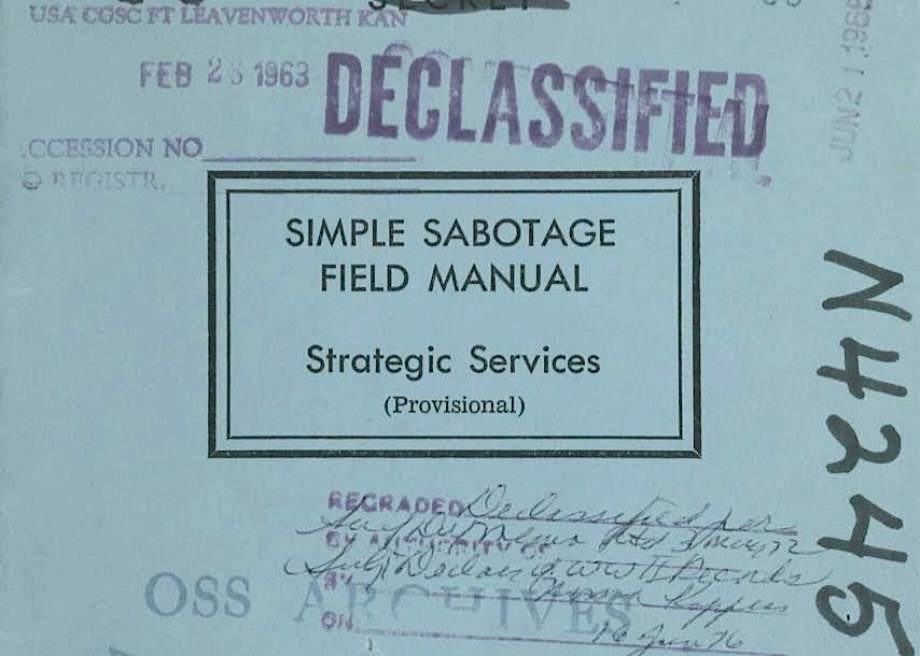[Most Recent Entries] [Calendar View]
Thursday, November 21st, 2024
- Insist on doing everything through “channels.” Never permit short-cuts to be taken in order to expedite decisions.
- Make “speeches.” Talk as frequently as possible and at great length. Illustrate your “points” by long anecdotes and accounts of personal experiences.
- When possible, refer all matters to committees, for “further study and consideration.” Attempt to make the committee as large as possible — never less than five.
- Bring up irrelevant issues as frequently as possible.
- Haggle over precise wordings of communications, minutes, resolutions.
- Refer back to matters decided upon at the last meeting and attempt to re-open the question of the advisability of that decision.
- Advocate “caution.” Be “reasonable” and urge your fellow-conferees to be “reasonable” and avoid haste which might result in embarrassments or difficulties later on.
- In making work assignments, always sign out the unimportant jobs first. See that important jobs are assigned to inefficient workers.
- Insist on perfect work in relatively unimportant products; send back for refinishing those which have the least flaw.
- To lower morale and with it, production, be pleasant to inefficient workers; give them undeserved promotions.
- Hold conferences when there is more critical work to be done.
- Multiply the procedures and clearances involved in issuing instructions, pay checks, and so on. See that three people have to approve everything where one would do.
- Work slowly
- Work slowly.
- Contrive as many interruptions to your work as you can.
- Do your work poorly and blame it on bad tools, machinery, or equipment. Complain that these things are preventing you from doing your job right.
- Never pass on your skill and experience to a new or less skillful worker.
| Time | Event |
| 6:23a | Discover the CIA’s Simple Sabotage Field Manual: A Timeless Guide to Subverting Any Organization with “Purposeful Stupidity” (1944)
I’ve always admired people who can successfully navigate what I refer to as “Kafka’s Castle,” a term of dread for the many government and corporate agencies that have an inordinate amount of power over our permanent records, and that seem as inscrutable and chillingly absurd as the labyrinth the character K navigates in Kafka’s last allegorical novel. Even if you haven’t read The Castle, if you work for such an entity—or like all of us have regular dealings with the IRS, the healthcare and banking system, etc.—you’re well aware of the devilish incompetence that masquerades as due diligence and ties us all in knots. Why do multi-million and billion dollar agencies seem unable, or unwilling, to accomplish the simplest of tasks? Why do so many of us spend our lives in the real-life bureaucratic nightmares satirized in The Office and Office Space? One answer comes via Laurence J. Peter’s 1969 satire The Peter Principle—which offers the theory that managers and executives get promoted to the level of their incompetence—then, David Brent-like, go on to ruin their respective departments. The Harvard Business Review summed up disturbing recent research confirming and supplementing Peter’s insights into the narcissism, overconfidence, or actual sociopathy of many a government and business leader. But in addition to human failings, there’s another possible reason for bureaucratic disorder; the conspiracy-minded among us may be forgiven for assuming that in many cases, institutional incompetence is the result of deliberate sabotage from both above and below. The ridiculous inner workings of most organizations certainly make a lot more sense when viewed in the light of one set of instructions for “purposeful stupidity,” namely the once top-secret Simple Sabotage Field Manual, written in 1944 by the CIA’s precursor, the Office of Strategic Services (OSS). Now declassified and freely available on the CIA website, the manual that the agency describes as “surprisingly relevant” was once distributed to OSS officers abroad to assist them in training “citizen-saboteurs” in occupied countries like Norway and France. Such people, writes Rebecca Onion at Slate, “might already be sabotaging materials, machinery, or operations of their own initiative,” but may have lacked the devious talent for sowing chaos that only an intelligence agency can properly master. Genuine laziness, arrogance, and mindlessness may surely be endemic. But the Field Manual asserts that “purposeful stupidity is contrary to human nature” and requires a particular set of skills. The citizen-saboteur “frequently needs pressure, stimulation or assurance, and information and suggestions regarding feasible methods of simple sabotage.” You can read the full document here. Or find an easy-to-read version on Project Gutenberg here. To get a sense of just how “timeless”—according to the CIA itself—such instructions remain, see the abridged list below, courtesy of Business Insider. You will laugh ruefully, then maybe shudder a little as you recognize how much your own workplace, and many others, resemble the kind of dysfunctional mess the OSS meticulously planned during World War II. Organizations and Conferences Managers Employees Note: This post originally appeared on our site in December 2015. Related Content: The CIA’s Style Manual & Writer’s Guide: 185 Pages of Tips for Writing Like a Spook How the CIA Secretly Used Jackson Pollock & Other Abstract Expressionists to Fight the Cold War
Josh Jones is a writer and musician based in Durham, NC. Follow him at @jdmagness |
| 10:00a | An Introduction to the Astonishing Book of Kells, the Iconic Illuminated Manuscript Whatever set of religious or cultural traditions you come from, you’ve probably seen a Celtic cross before. Unlike a conventional cross, it has a circular ring, or “nimbus,” where its arms and stem intersect. The sole addition of that element gives it a highly distinctive look, and indeed makes it one of the representative examples of Insular iconography — that is, iconography created within Great Britain and Ireland in the time after the Roman Empire. Perhaps the most artistically impressive Celtic cross in existence is found on one of the pages of the ninth-century Book of Kells (view online here), which itself stands as the most celebrated of all Insular illuminated manuscripts. On what’s called the “carpet page” of the Book of Kells, explains Smarthistory’s Steven Zucker in the video above, “we see a cross so elaborate that it almost ceases to be a cross.” It has “two crossbeams, and these delicate circles with intricate interlacing in each of them, but the circles are so large that they almost overwhelm the cross itself.” That’s hardly the only image of note in the book, which contains the four Gospels of the New Testament, among other texts, as well as numerous and extravagant illustrations, all of them executed painstakingly by hand on its vellum pages back when it was created, circa 800, in the scriptorium of a medieval monastery. These illustrations include, as Zucker’s colleague Lauren Kilroy puts it, “the earliest representation of the Virgin and Child in a manuscript in Western Europe.”
This is hardly a volume one approaches lightly — especially if one approaches it in person, as Zucker and Kilroy did on their visit to Trinity College Dublin. “When we were standing in front of the book,” says Kilroy, they “noticed how many folios formed the book itself” (which would have required the skin of more than 100 young calves). Coming to grips with the sheer quantity of material in the Book of Kells is one thing, but understanding how to interpret it is another still. Hence the free online course previously featured here on Open Culture, which can help you more fully appreciate the book in its digitized form available online. Even if the cross, Celtic or otherwise, stirs no particular religious feelings within you, the Book of Kells has much to say about the civilization that produced it: a civilization that, insular though it may once have been, would go on to change the shape of the world. Related Content: The Medieval Masterpiece the Book of Kells Is Now Digitized and Available Online Take a Free Online Course on the Great Medieval Manuscript the Book of Kells Based in Seoul, Colin Marshall writes and broadcasts on cities, language, and culture. His projects include the Substack newsletter Books on Cities and the book The Stateless City: a Walk through 21st-Century Los Angeles. Follow him on Twitter at @colinmarshall. |
| << Previous Day |
2024/11/21 [Calendar] |
Next Day >> |


